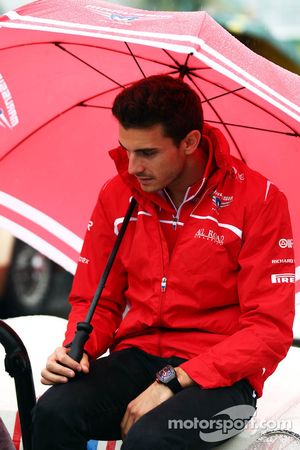Yes, a green flag was waving, but know the whole story
Motorsport.com takes a deeper look at the crash that put Jules Bianchi in the hospital.

Photo by: Motorsport.com

















In an amateur video that's been making the rounds on social media, you can clearly see Jules Bianchi impact the tractor that was trying to carry Adrian Sutil's car away.
Another thing you see is a man in the marshal's post, waving a green flag as the crash happens and then afterwards. Many people, including us momentarily, were baffled as to why this green flag was waving.
The marshal did nothing wrong, but the FIA did
On closer inspection of the video and FIA rulebook, it becomes clear. The marshal himself did nothing wrong. He followed the rules and did what was required of him. My problem is with the FIA themselves.
The man was waving double yellow flags when Sutil originally crashed, as instructed by race control. Once the tractor lifted the Sauber, it began to move back towards the opening in the wall. Once it moved past the marshal post, he immediately switched to a green flag, as per the regulations.
Taking a closer look
In laymen's terms, that green flag signifies to drivers that you may now accelerate at this point. First and foremost, that tractor was still mere feet away from the marshal's post when the flags were switched and was by no means in a safer location. A number of track workers walked with it, balancing the Sauber in the air with ropes. That area should have remained a yellow flag zone, despite it technically being beyond the accident scene. The zone directly before it was still yellow. There is still confusion regarding exactly what zones were yellow or not and at what time.
11 seconds after the green flag was displayed, Bianchi came upon the accident scene. Like Sutil, he lost the rear and aquaplaned off the circuit. Unlike Sutil, he tried to correct the car to the point where he overcorrected. The car was now heading across a soaking wet gravel trap, upwards of 130mph (210kph), before striking the tractor in a vicious impact that obliterated a good portion of the Marussia. You can see the video (but be warned, it may be upsetting to some) HERE.
Equipment/people on circuit should warrant a SC
Jules Bianchi now lays unconscious in a hospital, fighting for his life. Did this green flag have anything to do with Bianchi's crash? We can't honestly say but that's beside the point I'm trying to make. However, the flag means you can accelerate beyond this zone. Looking at the telemetry, Bianchi was already accelerating.
Regardless of what the rules say, that marshals post was way too close to the crash scene for the green flag to be shown. That tractor and those workers were still in a very dangerous situation. In my opinion, there should be a safety car in such a situation, but at the very least, do not withdraw the double yellows until everyone and everything is back safely behind those barriers.
A number of factors created Perfect Storm
Just look at the infographic. It shows how incredibly close the end of the yellow flag zone, the crash site, and the marshal post are. Where is the margin for error? There is none. This situation is like a plane crash though ... A number of factors led to the end result. However, the weather, Bianchi, the FIA rules, the position of the tractor, the diminishing light, and other unknowns created a 'perfect storm' of sorts.
If I could see this coming, why couldn't the FIA? ... Excerpt from my July story
Back in the German GP, Adrian Sutil spun and abandoned his car on the front stretch. Safety workers were sent out to push the car out of harms way and with no safety car intervention. I was stunned by that decision and I think what I said then still applies now...
Basing Safety on Probability
"They based their decision on probability. They based a decision that could put the lives of both track workers and racing drivers in jeopardy on the probability that something won't happen. You're just asking for trouble when you do stuff like that."
"Tell me, what was the probability of those events unfolding the way they did? It was unlikely, but still possible, and it happened. Placing a decision that could have dire consequences cost two men their lives that day. Let me ask you this. What was the probability that track marshal Frederick Jansen van Vuuren would get run down by a car in the 1977 South African Grand Prix? What was the probability that his fire extinguisher would strike racer Tom Pryce in the head, killing him instantly as well?"
"Why then are we still doing the exact same thing 37 years after that tragic incident when there's a much safer option just the push of a button away? You are playing with fire FIA....and you're eventually going to get burned."
You were warned
Let me repeat that last sentence again ... "You are playing with fire FIA....and you're eventually going to get burned." I'm no genius and I'm far from the first person to say such things, but alas, all those warnings fell on deaf ears. Now we must face the consequences of our ignorance.
You took an unnecessary risk FIA, and it cost Jules Bianchi. This could lead to the end of his promising F1 career or worse. It's past time to make sure we don't allow such a lack of judgement ever again, or this WILL happen again.
Be part of Motorsport community
Join the conversationShare Or Save This Story
Subscribe and access Motorsport.com with your ad-blocker.
From Formula 1 to MotoGP we report straight from the paddock because we love our sport, just like you. In order to keep delivering our expert journalism, our website uses advertising. Still, we want to give you the opportunity to enjoy an ad-free and tracker-free website and to continue using your adblocker.























Top Comments